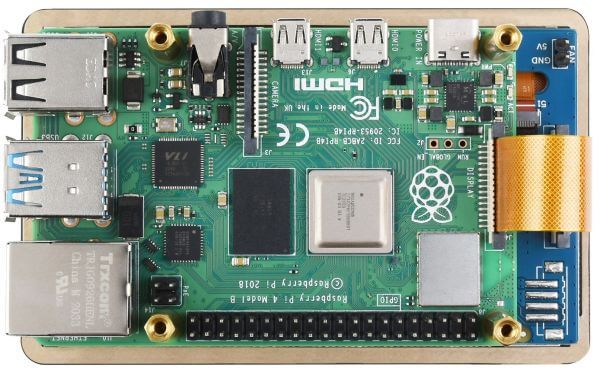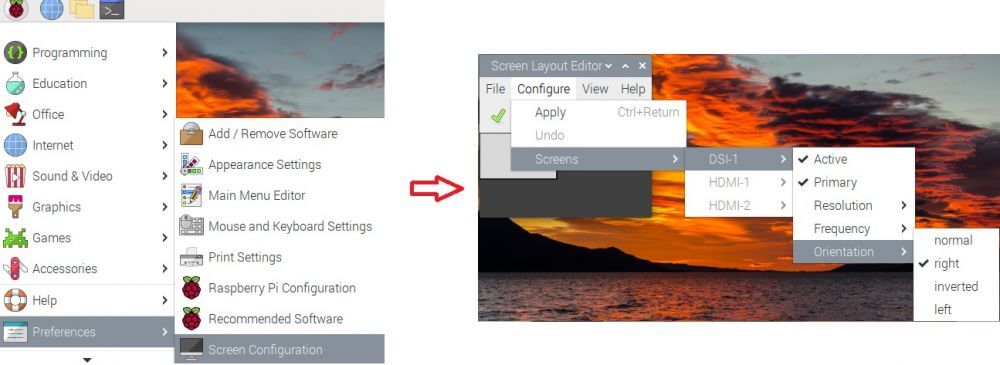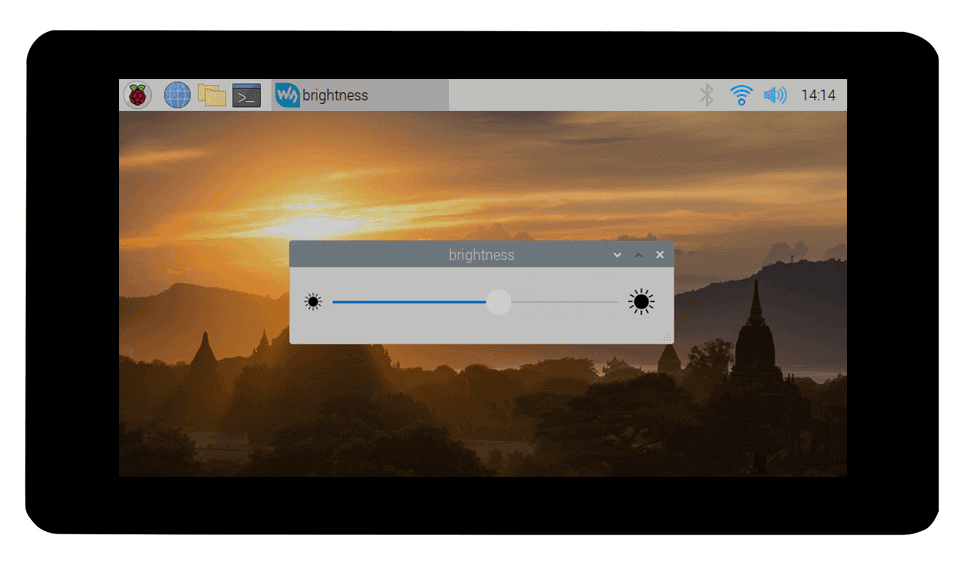- sales/support
Google Chat: zj734465502@gmail.com
- sales
+86-0755-88291180
- sales01
sales@spotpear.com
- sales02
dragon_manager@163.com
- support
tech-support@spotpear.com
- CEO-Complaints
zhoujie@spotpear.com
- sales/support
WhatsApp:13246739196
Raspberry Pi 4inch DSI LCD User Guide
Features
- 4inch IPS capacitive touch screen with a hardware resolution of 480 × 800.
- Adopts optical bonding tech, picture is clearer.
- Tempered glass capacitive touch panel, hardness up to 6H.
- Drive LCD directly through Raspberry Pi's DSI interface with a refresh rate of up to 60Hz.
- Working with Raspberry Pi, supports Raspberry Pi OS system.
- Supports Pi 4B/3B+/3A+, Another adapter cable is required for CM3+/4.
- Support backlight adjusted by software.
Working with Raspberry Pi
Hardware connection
1. Use a 15PIN FPC cable to connect the 4inch DSI LCD to the DSI interface of the Raspberry Pi.
2. The Raspberry Pi is installed on the display board with the back facing down, and the 5V power supply and I2C communication are connected through the 4PIN.
Software settings
Method 1: Install Manually
1) Download the image from the Raspberry Pi website.
2) Connect the TF card to the PC, and use SDFormatter software to format the TF card.
3) Open the Win32DiskImager software, select the system image downloaded in step 2, and click "write" to write the system image.
4) After the image has finished writing, save, and quit the TF card safely.
5) Connect the TF card to the Raspberry Pi, start the Raspberry Pi, and log in to the terminal of the Raspberry Pi (you can connect the Raspberry Pi to an HDMI display or log in remotely with ssh).
#Step 1: Download and enter the Waveshare-DSI-LCD driver folder
git clone https://github.com/waveshare/Waveshare-DSI-LCD
cd Waveshare-DSI-LCD
#Step 2: Enter uname -a in the terminal to view the kernel version, and cd to the corresponding file directory
#5.15.61 then run the following command
cd 5.15.61
#Step 3: Please check the bits of your system, enter the 32 directory for 32-bit systems, and enter the 64 directory for 64-bit systems
cd 32
#cd 64
#Step 4: Enter your corresponding model command to install the driver, pay attention to the selection of the I2C DIP switch
#4inch DSI LCD 480×800 Driver:
sudo bash ./WS_xinchDSI_MAIN.sh 40 I2C0
#Step 5: Wait for a few seconds, when the driver installation is complete and no error is prompted, restart and load the DSI driver and it can be used normally
sudo reboot
#Note: The above steps need to ensure that the Raspberry Pi can connect to the Internet normally.Note: The above steps need to ensure that the Raspberry Pi can be connected to the Internet normally.
6) Wait for the system to restart, it will be able to display and touch normally.
Method 2: Program Pre-install Image
1. Click to download Waveshare DSI LCD - Pi4 pre-install image and unzip it to get ".img" file.
2. Connect the TF card to the PC and use SDFormatter to format the TF card.
3. Open Win32DiskImager software, choose the system image prepared in the first step, and then click "write" to write the system image,
4. After programming, open the "config.txt" file in the root directory of the TF card. Modify it to the corresponding model of the driver, save and then safely remove the TF card.
[all]
ignore_lcd=1
dtparam=i2c_vc=on
dtparam=i2c_arm=on
#Choose DSI screen model (Comment out the dtoverlay of the corresponding model)
#DSI Display Model choose(Remove the dtoverlay comment corresponding to the display model)
#For example, 8inch DSI LCD (C) / 10.1inch DSI LCD(C) uses:
#Example 8inch DSI LCD (C) / 10.1inch DSI LCD(C) use:
dtoverlay=WS_xinchDSI_Screen,SCREEN_type=8,I2C_bus=10
dtoverlay=WS_xinchDSI_Touch,invertedx,swappedxy,I2C_bus=10
#2.8inch DSI LCD use:
#dtoverlay=WS_xinchDSI_Screen,SCREEN_type=0,I2C_bus=10
#dtoverlay=WS_xinchDSI_Touch,invertedy,swappedxy,I2C_bus=10
#4inch DSI LCD use:
#dtoverlay=WS_xinchDSI_Screen,SCREEN_type=1,I2C_bus=10
#dtoverlay=WS_xinchDSI_Touch,invertedx,swappedxy,I2C_bus=10
#7inch DSI LCD(C) use:
#dtoverlay=WS_xinchDSI_Screen,SCREEN_type=2,I2C_bus=1
#dtoverlay=WS_xinchDSI_Touch,dtoverlay=WS_xinchDSI_Touch,I2C_bus=1
#7.9inch DSI LCD use:
#dtoverlay=WS_xinchDSI_Screen,SCREEN_type=5,I2C_bus=10
#dtoverlay=WS_xinchDSI_Touch,invertedx,invertedy,I2C_bus=10
#11.9inch DSI LCD use:
#dtoverlay=WS_xinchDSI_Screen,SCREEN_type=6,I2C_bus=10
#dtoverlay=WS_xinchDSI_Touch,invertedx,invertedy,I2C_bus=10
#8inch DSI LCD (C) / 10.1inch DSI LCD(C) use:
#dtoverlay=WS_xinchDSI_Screen,SCREEN_type=8,I2C_bus=10
#dtoverlay=WS_xinchDSI_Touch,invertedx,swappedxy,I2C_bus=105. Connect the TF card to the Raspberry Pi, and start the Raspberry Pi, wait for about 30 seconds to display and touch normally.
Rotation
Method 1: Graphical Interface Rotation
In the start menu, select: Preferences->Screen Configuration->Configure->Screens->DSI-1->Orientation, select the corresponding angle in it, click "√", select Yes, and restart.

Method 2: Rotation Display In Lite Version
sudo nano /boot/cmdline.txt #Add a command corresponding to the display rotation angle at the beginning of the cmdline.txt file, save it and restart it to take effect #display rotated 90 degrees video=DSI-1:480x800M@60,rotate=90 #display rotated 180 degrees video=DSI-1:480x800M@60,rotate=180 #display rotated 270 degrees video=DSI-1:480x800M@60,rotate=270
Touch To Rotate
sudo nano /boot/config.txt #Modify the instruction of the touch rotation angle at the end of the config.txt file, and it will take effect after restarting (there is a 0° touch direction instruction by default) #90°: dtoverlay=WS_xinchDSI_Touch,invertedx,invertedy #180°: dtoverlay=WS_xinchDSI_Touch,invertedy,swappedxy #270°: dtoverlay=WS_xinchDSI_Touch #0°: dtoverlay=WS_xinchDSI_Touch,invertedx,swappedxy
Backlight Control
Method 1: Graphical Interface Dimming
Using the application provided by Waveshare:
cd Waveshare-DSI-LCD # Determine the currently used kernel version, such as the 5.15.61 kernel, and run the following command cd 5.15.61 #Check the bits of the system, 32-bit system enters 32 directory, 64-bit system enters 64 directory cd 32 #cd 64 cd Backlight sudo ./install.sh
After the installation is complete, you can open the program in the Start menu - > Accessories - > Brightness, as shown below:
Method 2: Lite Version Dimming Command
To adjust the system command of the lite version, after entering the root privilege, execute the following command on the Raspberry Pi terminal:
echo X > /sys/waveshare/rpi_backlight/brightness
(X value in the range of 0~255)
For example:
sudo su root echo 100 > /sys/waveshare/rpi_backlight/brightness
Note
1. Update the system, such as executing the following command
sudo apt-get update sudo apt-get full-upgrade
After updating the system, some files of the originally installed driver may be overwritten, and the driver needs to be reinstalled to display normally.
2. Replace the motherboard
If the driver originally installed on the Raspberry Pi 4 Model B, the user replaces the motherboard, such as modifying it to a Raspberry Pi 3 Model B+, the display will not display properly.
Because Pi4 and Pi3 need to load different driver files, you need to reinstall the driver on the new motherboard to display properly.





